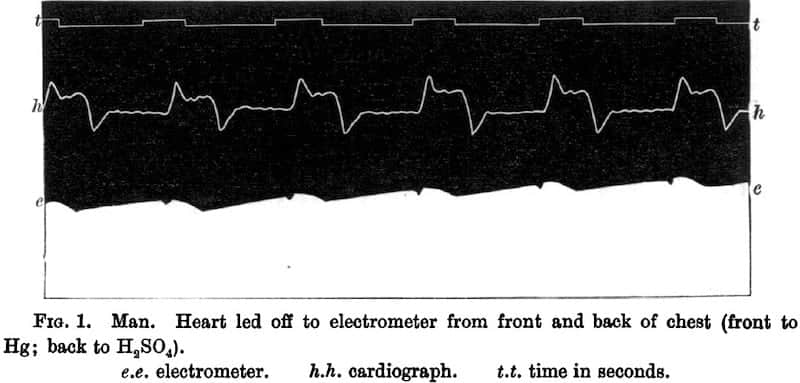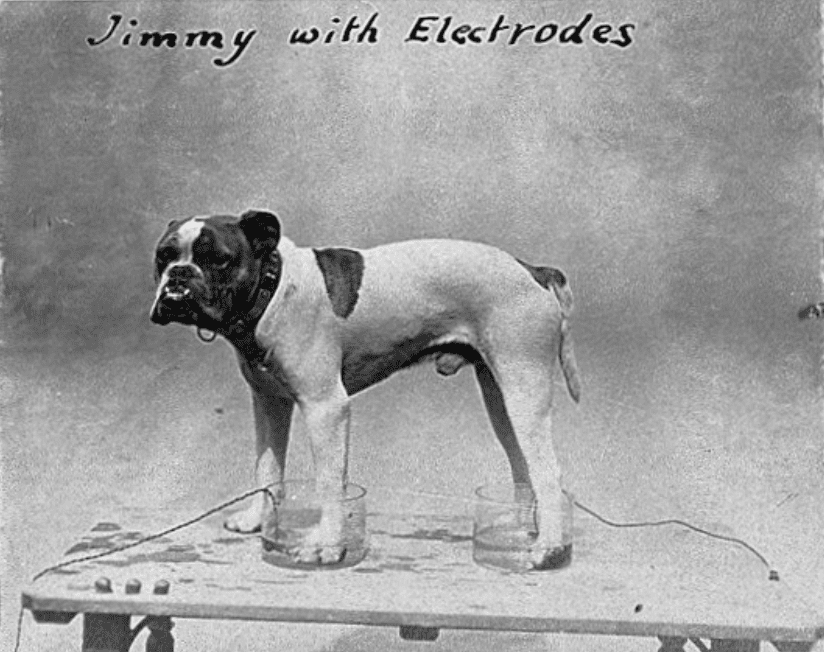Augustus Desiré Waller
Augustus Desiré Waller (1856 – 1922) was a British physiologist who recorded the first ever electrocardiogram (ECG).
In 1887 he used a Lippmann capillary electrometer… and a toy train, to record the first human tracing of the human heart, and first coined the term electrocardiogram (ECG)
In 1891 Waller proposed the expression for normal systolic duration, which Henry Cuthbert Bazett converted into the Bazett Formula for the measurement of QTc in 1920.
Physiology dominated Waller’s life. He had a home laboratory where his wife Alice Palmer (biscuit heiress of Huntley and Palmer) and five children and dog Jimmie participated in his experiments. His daughter Mary remembered packing for a trip and her mother asking the children what things they wanted to take, adding ‘but don’t forget, Father has bagged the galvanometer‘.
Biography
- Born on July 18, 1856 in Paris, France. His father worked in Paris and he was educated there until his father’s death in 1870, when he moved to Scotland with his mother.
- 1881 – MD, Aberdeen University
- 1883 – Lecturer in physiology at the School of Medicine for Women, London
- 1884 – Lecturer in physiology at St Mary’s Hospital, Paddington
- 1885 – Married one of his students, Alice Palmer, the daughter of Sir George Palmer (of Huntley and Palmer biscuit fame), and was greeted at his next St Mary’s lecture by a blackboard inscribed ‘Waller takes the biscuit’. With characteristic humour, Waller added ‘and the tin as well’.
- 1887 – Commenced work on the electrical activity of the heart, already well known from studies on the exposed heart, however Waller sought to demonstrate cardiac potentials from the limbs of intact animals and from man. He used a Lippman capillary electrometer to record the first ‘electrogram’ from both animals and man.
- 1888 – Elaborated on his studies which also proved that contraction of the heart was not a simultaneous process but showed initiation at the apex and termination at the base.
- 1892 – Fellow of the Royal Society (FRS)
- 1897 – Fullerian Professor of Physiology
- 1903 – Professor of physiology at the Physiological Laboratory of the University of London housed in the Imperial Institute
- 1905 – Consulting physician at the National Hospital for Diseases of the Heart
- Died on March 11, 1922
Key Medical Attributions
1887 – Waller used a capillary electrometer to record the first human electrocardiogram. Surface electrodes were strapped to the front and back of the chest producing two distorted deflections: ventricular depolarization and repolarization. He attached his equipment to a slowly moving toy train, allowing him to record the heart’s activity in real time.
If a pair of electrodes (zinc covered by chamois leather and moistened with brine) are strapped to the front and back of the chest, and connected with a Lippmann’s capillary electrometer, the mercury in the latter will be seen to move slightly but sharply at each beat of the heart. If the movements of the column of mercury are photographed on a travelling plate simultaneously with those of an ordinary cardiographic lever a record is obtained
Waller 1887

In an informal address at St Mary’s in 1915, Waller reminisced about his pioneer work.
I studied the hearts of all sorts of animals… and one fine day after leading off from the exposed heart of a decapitated cat to study the cardiogram by aid of a Lippman electrometer, it occurred to me that it ought to be possible to use the limbs as electrodes and thus lead off from the heart to the electrometer without exposing the heart, i.e. from the intact and normal organ. Obviously man was the most convenient animal to use so I dipped my right hand and left foot into a couple of basins of salt solution, which were connected with the two poles of the electrometer and at once had the pleasure of seeing the mercury column pulsate with the pulsation of the heart…
This first demonstration was made in St Mary’s laboratory in May 1887 and demonstrated there to many physiologists and among others, to my friend Professor Einthoven of Leiden…During the summer of that year, I made a complete survey of all sorts of leads from the hands and feet and mouth!’
Waller AD. Unpublished address at St Mary’s 1915 (personal communication from Mary Waller to Edwin Besterman, 1951).
The contraction of the ventricles is not simultaneous throughout the mass, but traverses it as a wave (at the present stage the direction of the wave of contraction is immaterial). Inequalities of potential, at different parts of the mass, are consequently established at the beginning and at the end of each systole. Or, to reverse the order of statement, the inequalities in question are proof of the passage of a wave of excitation. The distribution of these inequalities of potential is represented diagrammatically:
Waller 1889

Waller often demonstrated the electrogram using his dog “Jimmy” who would patiently stand with paws in glass jars of saline. Jimmy, had the distinction of having had a Parliamentary question asked of him in the House of Commons. In 1909 the Home Secretary Herbert Gladstone defended the dog’s public appearances, explaining that they were painless and Jimmy enjoyed them:
Q. ‘At a conversation of the Royal Society at Burlington House, a bulldog was cruelly treated when a leather strap with sharp nails was wound around his neck and his feet were immersed in glass jars containing salts in solution, and the jars in turn were connected with wires to galvanometers. Such a cruel procedure should surely be dealt with under the “Cruelty to Animals Act” of 1876 ?’
A. ‘The dog in question wore a leather collar ornamented with brass studs, and he was placed to stand in water to which some sodium chloride had been added, or in other words, common salt. If my honourable friend had ever paddled in the sea, he will appreciate fully the sensation obtained thereby from this simple pleasurable experience!’
1891 – Waller provided a series of values for the duration of mechanical systole with different heart rates. He demonstrated that the period of mechanical contraction (systole) was shortened at faster heart rates. See Fridericia Formula 1920
Interesting facts
In 1912, Willem Einthoven (1860 – 1927) credited Waller with coining the term and presenting the first electrocardiogram. In 1924 Einthoven was awarded the Nobel Prize for Medicine. Waller had died in 1922 and so would not have been eligible for a joint award.
It gives me an especial pleasure to bring to remembrance here that the human EKG was first recorded by a London physiologist, Augustus D. Waller, who also introduced the term “electrocardiogram” into science; and that Dr. Thomas Lewis, whose extensive researches have been crowned with such exceptional success, was the first man in England who applied electrocardiography to clinical investigations.
Einthoven 1912
Sir Thomas Lewis (1881-1945) popularized clinical electrocardiography and it is relevant here to quote the words of appreciation of Waller’s discovery made by Lewis which ran as follows:
His early work on electro-physiology was extensive, thorough, and is well known. He was the first to show that the currents set up by the beating of the human heart can be recorded; he was the first to obtain a human electro-cardiogram; this has been the main though by no means his sole contribution to the science of experimental medicine. The discovery long preceded the introduction of the string galvanometer, and was the more remarkable in that it was accomplished in the eighties.
Thomas Lewis 1922
Augustus Desiré Waller used his full name in order to distinguish himself from his eminent father, Augustus Volnay Waller (1816–1870), who is remembered for:
- Diapedesis: His thesis involved examination of the frog’s tongue micro-circulation. Waller observed white blood cells (but not red ones) could squeeze between capillary cells.
- Wallerian degeneration of the nerves: Sections of frog’s tongue to show nerves produced ‘necklaces of droplets‘ (degenerating myelin) on one side of the cut – an indication of the direction in which the nerve normally conducted.
Major Publications
- Waller AD. A demonstration on man of electromotive changes accompanying the heart’s beat. Journal of Physiology 1887;8:229-34. [First ECG in Man]
- Waller AD. Introductory Address on the Electromotive Properties of the Human Heart. Br Med J. 1888; 2(1449): 751-754
- Waller AD. On the electromotive changes connected with the beat of the mammalian heart, and of the human heart in particular. Philosophical Transactions of the Royal Society B 1889; 180: 169–194.
- Waller AD. An introduction to Human physiology. 1891.
- Waller AD. A lecture on the administration of chloroform to man and to the higher animals: delivered in the Physiological Laboratory of the University of London on October 13th, 1903
- Waller AD. Physiology; the servant of medicine. Chloroform in the laboratory and in the hospital. Univ. of London Press. 1910.
- Waller AD. A contribution to the psychology of logic, considered from a physiological standpoint. University of London Press. 1912.
References
Biography
- Halliburton WD. Augustus Désiré Waller 1856-1922. Royal Society obituary notices 1922
- Cope Z. Augustus Desire Waller (1856-1922). Med Hist 1973; 17: 80-85
- Besterman E, Creese R. Waller–pioneer of electrocardiography. Br Heart J. 1979; 42(1): 61-64
- Sykes AH. Servants of Medicine: Augustus Waller—father and son physiologists. J R Soc Med. 2005; 98(4): 185–186
- Bibliography. Waller, Augustus Désiré 1856-1922. WorldCat Identities
Eponymous terms
- Einthoven W. The different forms of the human electrocardiogram and their signification. Lancet 1912; 179(4622): 853-861
- Waller MD. Discovery of the Electrocardiogram. Br Med J. 1950; 1(4660): 1008–1009.
- Sykes AH. A D Waller and the electrocardiogram, 1887. Br Med J (Clin Res Ed). 1987; 294(6584): 1396-8
- Cadogan M. History of the Electrocardiogram. LITFL 2020
- Morris T. The first electrocardiogram (ECG). 2021
[cite]
MBBS DDU (Emergency) CCPU. Adult/Paediatric Emergency Medicine Advanced Trainee in Melbourne, Australia. Special interests in diagnostic and procedural ultrasound, medical education, and ECG interpretation. Co-creator of the LITFL ECG Library. Twitter: @rob_buttner




